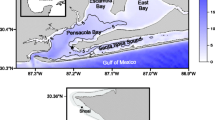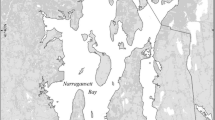Abstract
High frequency dissolved oxygen data were analyzed to calculate primary production, respiration and net ecosystem metabolism (NEM) from 42 sites within 22 National Estuarine Research Reserves (NERR), 1995–2000. NERR sites are characterized by a variety of dominant plant communities including phytoplankton, salt marsh, seagrass, macroalgae, freshwater macrophyte, and mangrove, and are representative of the coastal bioregions of the United States. As expected from the wide diversity of sites, metabolic rates were temporally and spatially variable with the highest production and respiration occurring during the summer in Southeastern estuaries. Sites within different regions exhibited consistent seasonal trends in production, respiration, and NEM. Temperature was the most important environmental factor explaining within-site variation in metabolic rates; nutrient concentrations were the second most important factor. All but three of the 42 sites were heterotrophic (respiration was greater than production) on an annual basis. Habitat adjacent to the monitoring site, estuarine area, and salinity explained 58% of the variation in NEM. Open water sites or sites adjacent to mangroves or in marsh creeks were heterotrophic, while sites in or adjacent to submerged aquatic vegetation (eelgrass or macroalgal beds) were either autotrophic or near balance. Estuarine area was also a significant factor explaining variability in NEM; larger systems were closer to balance than smaller systems that trended toward heterotrophy. Freshwater sites were more heterotrophic than saline sites. Nutrient loading explained 68% of the variation in NEM among some of the sites. When these estimates were compared to the literature, metabolic rates from the NERR sites were much larger, often two to five times greater than rates from other estuarine and coastal systems. One explanation is that these small, generally shallow sites located near shore may have greater allochthonous organic inputs as well as significant benthic primary production than the large, deeper systems represented by the literature.
Similar content being viewed by others
Literature Cited
Boynton, W. R. 1975. Energy basis of a coastal region: Franklin county and Apalachicola Bay, Florida, Ph.D. Dissertation, University of Florida, Gainesville, Florida.
Caffrey, J. M. 2003. Production, respiration and net ecosystem metabolism in U.S. estuaries.Environmental Monitoring and Assessment 81:207–219.
Carrfey, J. M., J. E. Cloern, andC. Grenz. 1998. Changes in production and respiration during a spring phytoplankton bloom in San Francisco Bay, California: Implications for net ecosystem metabolism.Marine Ecology Progress Series 172:1–12.
Cai, W.-J., L. R. Pomeroy, M. A. Moran, andY. Wang. 1999. Oxygen and carbon dioxide mass balance for the estuarine-intertidal marsh complex of five rivers in the southeastern U.S..Limnology and Oceanography 44:639–649.
Copeland, B. J. andW. R. Duffer. 1964. Use of a clear plastic dome to measure gaseous diffusion rates in natural waters.Limnology and Oceanography 9:494–499.
D'Avanzo, C., J. N. Kremer, andS. C. Wainright. 1996. Ecosystem production and respiration in response to eutrophication in shallow temperature estuaries.Marine Ecology Progress Series 141:263–274.
Eyre, B. D. andL. J. McKee. 2002. Carbon, nitrogen, and phosphorus budgets for a shallow subtropical coastal embayment (Moreton Bay, Australia).Limnology and Oceanography 47: 1043–1055.
Gattuso, J.-P., M. Frankignoulle, andR. Wollast. 1998. Carbon and carbonate metabolism in coastal aquatic ecosystems.Annual Reviews in Ecology and Systematics 29:405–434.
Hartman, B. andD. E. Hammond. 1984. Gas exchange rates across the sediment water and air-water interfaces in South San Francisco Bay.Journal of Geophysical Research 89:3593–3603.
Heip, C. H. R., N. K. Goosen, P. M. J. Herman, J. Kromkamp, J. J. Middelburg, andK. Soetaert, 1995. Production and consumption of biological particles in temperature tidal estuaries.Oceanography and Marine Biology Annual Reviews 33:1–149.
Hopkinson, Jr.,C. S. 1988. Patterns of organic carbon exchange between coastal ecosystems: The mass balance approach in salt marsh ecosystems, p. 122–154.In B. O. Jansson (ed.), Coastal-Offshore Ecosystems Interactions. Springer Verlag. Berlin, Germany.
Howarth, R. W., R. Schneider, andD. Swaney. 1996. Metabolism and organic carbon fluxes in the tidal freshwater Hudson River.Estuaries 19:848–865.
Kemp, W. M. andW. R. Boynton. 1980. Influence of biological and physical processes on dissolved oxygen dynamics in an estuarine system: Implications for measurement of community metabolism.Estuarine, Coastal and Marine Science 11:407–431.
Kemp, W. M., E. M. Smith, M. Marvin-DiPasquale, andW. R. Boynton. 1997. Organic carbon balance and NEM in Chesapeake Bay.Marine Ecology Progress Series 150:229–248.
Marino, R. andR. W. Howarth. 1993. Atmospheric oxygen exchange in the Hudson River: Dome measurements and comparison with other natural waters.Estuaries 16:433–445.
Nixon, S. W., S. L. Granger, andB. L. Nowicki. 1995. An assessment of the annual mass balance of carbon, nitrogen and phosphorus in Narragansett Bay.Biogeochemistry 31:15–61.
Odum, H. T. 1956. Primary production in flowing waters.Limnology and Oceanography 1:102–117.
Oviatt, C. A., A. A. Keller, P. A. Sampou, andL. L. Beatty. 1986. Patterns of productivity during eutrophication: A mesocosm experiment.Marine Ecology Progress Series 28:69–80.
Raymond, P. A., J. E. Bauer, andJ. J. Cole. 2000. Atmospheric CO2 evasion, dissolved inorganic carbon production and net heterotrophy in the York River estuary.Limnology and Oceanography 45:1707–1717.
Raymond, P. A. andJ. J. Cole. 2001. Gas exchange in rivers and estuaries: Choosing a gas transfer velocity.Estuaries 24:312–317.
Smith, S. V. andJ. T. Hollibaugh. 1993. Coastal metabolism and the oceanic organic carbon balance.Reviews of Geophysics 31:75–89.
Smith, S. V. andJ. T. Hollibaugh. 1997. Annual cycle and interannual variability of ecosystem metabolism in a temperature climate embayment.Ecological Monographs 67:509–533.
Swaney, D. P., R. W. Howarth, andT. J. Butler. 1999. A novel approach for estimating ecosystem production and respiration in estuaries. Application to the oligohaline and mesohaline Hudson River.Limnology and Oceanography 44:1509–1521.
Twilley, R. R. 1988. Coupling of mangroves to the productivity of estuarine and coastal waters, p. 155–180.In B. O. Jansson (ed.), Coastal-Offshoré Ecosystems Interactions. Springer Verlag, Berlin, Germany.
Wenner, E. L., A. F. Holland, M. D. Arendt, D. Edwards, andJ. M. Caffrey. 2001. A Synthesis of Water Quality Data from the National Estuarine Research Research System-Wide Monitoring Program. NOAA Grant NA97OR0209, MRD Contribution No. 459. NOAA, Silver Spring, Maryland.
Source of Unpublished Materials
Land-Ocean Interactions in the Coastal Zone (LOICZ). 2003. Biogeochemical Modelling Node. http://data.ecology. su.se/MNODE/
Author information
Authors and Affiliations
Corresponding author
Rights and permissions
About this article
Cite this article
Caffrey, J.M. Factors controlling net ecosystem metabolism in U.S. estuaries. Estuaries 27, 90–101 (2004). https://doi.org/10.1007/BF02803563
Received:
Accepted:
Issue Date:
DOI: https://doi.org/10.1007/BF02803563




